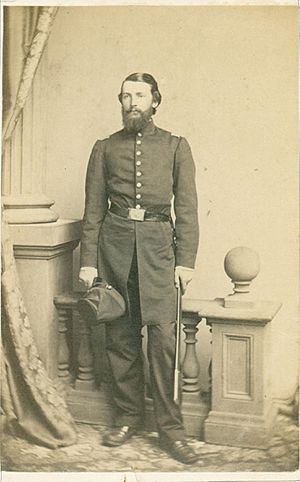Norwood Penrose Hallowell facts for kids
Quick facts for kids
Norwood Penrose Hallowell
|
|
|---|---|

Hallowell as a captain in the Union Army, 1862
|
|
| Born | April 13, 1839 Philadelphia, Pennsylvania |
| Died | April 11, 1914 (aged 74) Medford, Massachusetts |
| Place of burial |
Mount Auburn Cemetery
Cambridge, Massachusetts |
| Allegiance | |
| Years of service | 1861 – 1863 |
| Rank | |
| Unit | 20th Massachusetts Volunteer Infantry 54th Massachusetts Volunteer Infantry |
| Commands held | 55th Massachusetts Volunteer Infantry |
| Battles/wars | American Civil War - Battle of Ball's Bluff - Battle of Glendale - Battle of Antietam - Second Battle of Charleston Harbor |
Norwood Penrose "Pen" Hallowell (born April 13, 1839 – died April 11, 1914) was a brave officer in the Union Army during the American Civil War. He was one of three brothers who fought with great courage. Norwood and his brother Edward Needles Hallowell became leaders of some of the first all-black regiments. He was also a close friend and influence on Oliver Wendell Holmes Jr., who later became a famous judge on the Supreme Court. They were classmates at Harvard and fought together in the war.
Contents
Early Life and Education
Norwood Hallowell was born in Philadelphia, Pennsylvania in 1839. His parents were Morris Longstreth and Hannah (Penrose). Norwood and his brothers, Edward Needles and Richard Price, grew up in a Quaker family. Quakers are a religious group known for their peaceful beliefs. His family was also strongly abolitionist, meaning they were against slavery. During the Civil War, his father even turned their home into a hospital for wounded Union soldiers.
Norwood went to Harvard College, where he became good friends with Oliver Wendell Holmes Jr.. He finished college in 1861. His sister, Anna Hallowell, was a nurse during the Civil War. She later worked to improve education.
Serving in the Civil War
Norwood Hallowell strongly believed that slavery was wrong. This belief led him to join the Union Army in the Civil War. He also inspired his friend, Oliver Wendell Holmes Jr., to join.
Early Battles and Injuries
Hallowell became a first lieutenant on July 10, 1861. He joined the 20th Massachusetts Volunteer Infantry with Holmes. He fought in the Battle of Ball's Bluff on October 21, 1861. In this battle, he showed great bravery by leading soldiers to hold back Confederate forces. He then swam across the Potomac River. He built a simple raft and made several trips to rescue trapped Union soldiers.
Hallowell was promoted to captain on November 26, 1861. He was wounded in the Battle of Glendale on June 30, 1862. He suffered more serious wounds at the Battle of Antietam on September 17. A bullet shattered his left arm, but doctors were able to save it. Holmes was shot in the neck during the same battle. Both friends found safety in a farmhouse and were later taken to safety.
Leading All-Black Regiments
On April 17, 1863, Hallowell was promoted to lieutenant colonel. He became the second-in-command of the 54th Massachusetts. This was one of the first all-black regiments in the U.S. Army. The governor of Massachusetts was told that Hallowell was brave and smart. He was also willing to lead a black regiment, even though some people at the time did not like the idea.
On May 30, Governor John A. Andrew personally asked Hallowell to become a colonel. He was asked to command the 55th Massachusetts, another all-black regiment. Hallowell and his regiment were sent to Charleston Harbor. They took part in the attack and capture of Fort Wagner. Hallowell was one of the first soldiers to enter the fort after the enemy left it.
Hallowell continued to have problems from his war wounds. He was honorably discharged from the army on November 2, 1863.
Life After the War
After the war, Hallowell moved to New York City. He worked in business, first for Watts, Crane & Co. Then he started a partnership with his brother Richard.
On January 27, 1868, he married Sarah Wharton Haydock in New York. They had six children together: Anna, Robert Haydock, Norwood Penrose, John White, Esther Fisher, and Susan Morris.
In 1869, he moved to Medford, Massachusetts. He became a wool broker in Boston. In 1886, he was made vice president of the National Bank of Commerce in Boston.
Death and Lasting Impact
Norwood Hallowell died in Medford on April 11, 1914. He passed away just two days before his 75th birthday. His friend, Oliver Wendell Holmes Jr., wrote that Hallowell's death left "a great space bare for him." Holmes called him his "oldest friend" and said he was "the most generously gallant spirit and I don't know but the greatest soul I ever knew." He also said Hallowell "gave the first adult impulse to my youth."
An African American writer named Benjamin Griffith Brawley dedicated his 1921 book, A Social History of the American Negro, to Norwood Penrose Hallowell. He called Hallowell a "patriot." Norwood Hallowell is buried in his family's plot at Mount Auburn Cemetery in Cambridge, Massachusetts.

